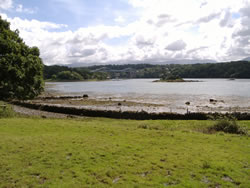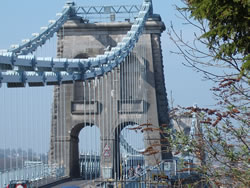The Menai Suspension Bridge
Anglesey is separated from the mainland of North Wales by the Menai Straits, a stretch of water known for its tidal range and fierce currents. Before the Straits were bridged in 1826, travellers were faced with crossing the Lavan Sands at low tide, or using a ferry, and a ferry crossing was often unpleasant or even impossible if weather conditions were poor. By 1800, with the passing of the Act of Union with Ireland, increasing numbers of passengers were using the important London-Dublin route, and the Government of the day decided a bridge was the logical way forward. The result is Thomas Telford's iconic bridge in a majestic setting.
Apart from the difficulty of constructing what would be the largest bridge of its type in a difficult environment, the problems were increased by Admiralty demands that the bridge should be a minimum of 100 feet above mean sea level. At this time, Britain was a maritime nation, with a fleet of tall ships, and the Admiralty's stipulation was to ensure ships could pass beneath the bridge under full sail. When completed, the bridge was 1,007 feet (305 metres) in length, with a central span of 584 feet (177 metres). A toll was charged until 1940.






